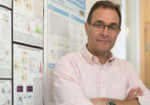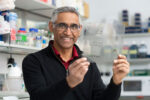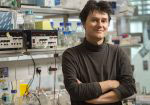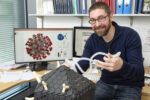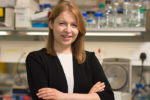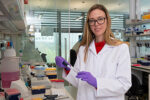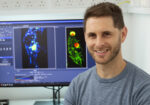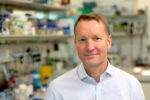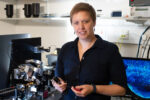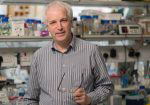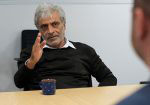H-to-M
Michael Hastings
LMB Division - Neurobiology
Neurons and biological timing: molecular neurobiology of the circadian clock
Circadian rhythms are those daily cycles of physiology and behaviour that persist when organisms are isolated from the external world. They are expressed at all levels of life, from prokaryotic blue-green algae to higher plants and animals. More…
Ramanujan Hegde
LMB Division - Cell Biology
Membrane protein biosynthesis and quality control
Cells are highly compartmentalized into numerous membrane-bound organelles. The membranes that define each organelle contain unique sets of embedded proteins that impart distinct functionalities to that organelle. How are all these different proteins selectively targeted to their correct destinations? And once they get there, how are membrane proteins inserted, folded, and assembled properly into the lipid bilayer? More…
Philipp Holliger
LMB Division - Protein and Nucleic Acid Chemistry
Evolution of novel biopolymers
A critical event in the origin of life is thought to be the emergence of a molecule capable of self-replication as well as mutation, and hence evolution towards more efficient replication. We have built a powerful in vitro system for directed evolution, called compartmentalized self-replication (CSR), which mimics this process in the laboratory. More…
Leo James
LMB Division - Protein and Nucleic Acid Chemistry
Host-Pathogen Biology
Despite extracellular adaptive and innate immunity, viral and bacterial pathogens are still able to infect cells. Because of this there must be a way to neutralise pathogens once they are inside the cell. Historically, infected cells have been seen as largely helpless and only able to signal for help. More…
Gregory Jefferis
LMB Division - Neurobiology
Genes, Circuits and Behaviour in Drosophila
Our broad goal is to understand how smell turns into behaviour in the fruit fly brain. We currently use a combination of genetic labelling and manipulation, targeted in vivo whole cell patch clamp recording and high resolution computational neuroanatomy to study olfactory circuits. More…
Joergen Kornfeld
LMB Division - Neurobiology
Connectomics of learned behaviour
How do animals store learned behaviours in their neuronal networks and retrieve them when performing those behaviours? It is widely believed that the connections between neurons, or synapses, are the memory substrate. The sum total of all these synaptic connections is called the connectome. More…
Patrycja Kozik
LMB Division - Protein and Nucleic Acid Chemistry
Dendritic cells and initiation of immune responses
Dendritic cells play a key role in initiation of cytotoxic immune responses against pathogens and tumours. In order to prime the relevant T cells, they acquire antigens from infected or cancer cells and process them for presentation on MHC class I molecules. More…
Madeline Lancaster
LMB Division - Cell Biology
Human brain development and evolution
Human brain development exhibits a number of unique characteristics, such as dramatic size expansion, unique cell types, and distinct neural stem cell behaviors. More…
Roni Levin Konigsberg
LMB Division - Cell Biology
Molecular Physiology of Phagocytic Cells in Health and Disease
Our bodies are continuously challenged by external and internal microscopic materials that include microorganisms, ‘bad’ cholesterol, dead cells (over 200 billion cells die within our bodies every day) and protein aggregates. If these materials are not promptly cleared from our system, they can lead to a wide range of diseases that include infections, heart disease, autoimmunity and neurodegeneration. More…
Kate McDole
LMB Division - Cell Biology
Morphogenesis of the early mammalian embryo
Development begins with a single cell of limitless potential giving rise to all of the different cell types, tissues, and organ systems that comprise an adult animal. How cells organize to build tissues and how those tissues are sculpted to form organs is largely unknown. More…
Andrew McKenzie
LMB Division - Protein and Nucleic Acid Chemistry
Investigation of immune and haematopoietic disorders
Immune cells secrete a spectrum of interleukins, which play a critical role in regulating antibody production, inflammation and haematopoiesis. Dysregulation of these factors can lead to the manifestation of diseases such as asthma, autoimmunity and leukaemia More…
Harvey McMahon
LMB Division - Neurobiology
Membrane curvature as an organising principle for eukaryotic cell biology
Cell shape is adapted to function. Organelle shape and local membrane architectures are likewise optimised for the processes that take place on and within these microenvironments. More…
Sean Munro
LMB Division - Cell Biology
Organisation of the Golgi apparatus
The compartments of the secretory and endocytic pathways are connected by membrane-bound carriers that bud from, and then fuse with, specific organelles. The accuracy of this traffic depends on the organelles having an 'identity' by which the trafficking machinery can recognise them. More…
Garib Murshudov
LMB Division - Structural Studies
Computational structural biology
Proteins, nucleic acids and other biological macromolecules take part virtually in all processes within living organisms. Knowledge of their 3-dimensional structures is essential for understanding how they work. X-ray crystallography is a powerful experimental technique that gives 3D structures with high accuracy. More…
